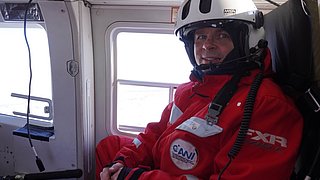Despite a storm and the adverse ice conditions, he and his team reached the MOSAiC floe almost as planned. They left the floe on 16 May and reached the sea-ice edge on Tuesday, 2 June. Now Torsten Kanzow is on board the research vessel Maria S. Merian, heading back to Bremerhaven from Svalbard.
meereisportal.de: Mr Kanzow: When you arrived at the MOSAiC floe, what did you find?
Torsten Kanzow: When we reached RV Polarstern in late February, it was still during the Polar Night. The personnel transfer took place under the coldest conditions of the entire expedition, with wind-chill temperatures down to -60°C: a major problem. First of all, the extreme temperatures posed a very real logistical challenge for exchanging cargo between the two ships; secondly, they made our fieldwork much harder to complete.
After about ten days, the work on site was affected by a new ice dynamic. This was because the Polarstern was in the middle of a large shear zone between floe systems. As the expedition continued, this dynamic stayed with us. As a result, the ship was constantly subjected to the prevailing ice pressure. Pressure ridges and leads formed, making it harder for us to access and move about on the surface of the floe. It was e.g. difficult to maintain the power supply for the monitoring systems on the ice, forcing us to use generators in some cases.
meereisportal.de: What were the most positive experiences in your view?
The team spirit that brought together the researchers, technicians, logistics staff, and crew of the FS Polarstern, and the hard work poured into the logistics needed to keep the monitoring systems up and running, so as not to lose any data. And in the midst of overcoming these challenges, we were caught unawares by the corona pandemic. As a result, the campaign of aerial survey flights we’d originally planned had to be cancelled, together with the plan to transfer teams by aeroplane in mid-April. What followed was a month of uncertainty on board. Nevertheless, the AWI successfully flew out a small number of participants with health problems – despite the fact that only half of the landing strip on the ice was still serviceable. At the same time, there was an enormous sense of team spirit: everyone threw themselves into their duties, the monitoring work continued without interruption, and I’m proud to say we continued all of our measurements – in the atmosphere, ice, snow and ocean, and including the time series, the areal readings taken on and below the ice, and the aerial surveys by helicopter.
meereisportal.de: What does this ice dynamic mean from a research perspective?
Well, the ice dynamic constantly put limits on the work we could do, leading to internal discussions on how to best respond. But the ice dynamic wasn’t just a logistical problem; it was also an outstanding object of study – pressure ridges, and their effects on energy transfer, lead formation and biological activity, which were revealed – we finally had the chance to monitor and investigate all these things that take place on the ocean in winter, yielding a treasure trove of new data.
meereisportal.de: Did the prolonged expedition also have its positive sides?
Thanks to the extended expedition time, we were still there for the transition to the melting season. It was interesting to see that the transition isn’t gradual; it progresses in phases. So as early as April we had warm-air fronts that paved the way for the melting. Then there was a major storm in mid-May, which churned up the cold air masses in the Arctic, signalling the transition to summer.
meereisportal.de: And then it was time to say farewell to the MOSAiC floe ...
That’s right; in late April we began preparing to leave the floe, so as to complete the transfer of researchers and crewmembers off the coast of Svalbard. We also made plans for bringing several critical pieces of equipment back on board, and leaving others behind to continue taking readings while the ship was away. Here it was a blessing that we’d already brought quite a bit back on board to protect it from the storm in May. After the storm, the MOSAiC floe began breaking up on a scale we hadn’t seen before. We then chose to stay on the floe longer, in order to retrieve further monitoring systems. Since many of them had already been dismantled, we were fortunately able to save the majority, so as to pass it on to the team for Leg 4. As a result, the on-site work can continue. Of course, we didn’t manage to save it all: there were also instruments and installations that had been crushed by the ice, or were simply nowhere to be seen. On 16 May we departed the floe, traveling 160 nautical miles to the sea-ice edge. Initially this went incredibly slowly – for the entire first week, we only made five miles of headway per day. But everyone on board was very flexible and contributed their expertise to this part of the journey, leading up to the rendezvous at Svalbard: the on-board helicopter crew, who flew scouting flights, the meteorologists, who never seemed to stop working, so as to provide weather forecasts for the flights, and the sea-ice physicists, who continued their ice observations.
meereisportal.de: What did you miss most while on the expedition, and what’s the first thing you’ll do when you get home?
During the journey, I missed my family most: my wife and our two children. I simply can’t wait to see them again; then I’m sure we’ll all decide what to do together.
meereisportal.de: Thanks for the first glimpses of this exciting part of the expedition, and best of luck with resting and re-acclimating after so much time away from home!
Contacts
- Prof. Dr. Torsten Kanzow (AWI)
- Dr Klaus Grosfeld (AWI)
- Dr Renate Treffeisen (AWI)
Questions?
Contact us via E-Mail or our contact form.
Graphics





